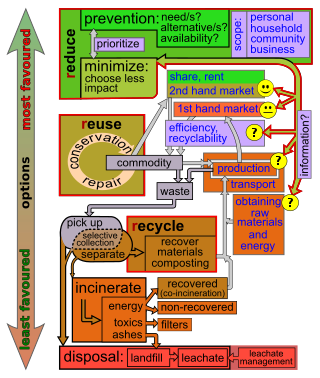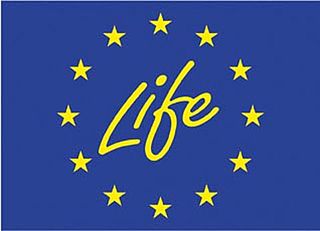
The Trans-European Transport Network (TEN-T) is a planned network of roads, railways, airports and water infrastructure in the European Union. The TEN-T network is part of a wider system of Trans-European Networks (TENs), including a telecommunications network (eTEN) and a proposed energy network. The European Commission adopted the first action plans on trans-European networks in 1990.

Waste (management) hierarchy is a tool used in the evaluation of processes that protect the environment alongside resource and energy consumption from most favourable to least favourable actions. The hierarchy establishes preferred program priorities based on sustainability. To be sustainable, waste management cannot be solved only with technical end-of-pipe solutions and an integrated approach is necessary.

The European Structural and Investment Funds are financial tools governed by a common rulebook, set up to implement the regional policy of the European Union, as well as the structural policy pillars of the Common Agricultural Policy and the Common Fisheries Policy. They aim to reduce regional disparities in income, wealth and opportunities. Europe's poorer regions receive most of the support, but all European regions are eligible for funding under the policy's various funds and programmes. The current framework is set for a period of seven years, from 2021 to 2027.
The European Institute of Innovation and Technology (EIT) is an independent body of the European Union with juridical personality, established in 2008 intended to strengthen Europe's ability to innovate. The EIT’s three “core pillars” of activities are: entrepreneurial education programmes and courses across Europe that transform students into entrepreneurs; business creation and acceleration services that scale ideas and budding businesses; and innovation-driven research projects that turn ideas into products by connecting partners, investors, and expertise.
A Vehicular ad hoc network (VANET) is a proposed type of mobile ad hoc network (MANET) involving road vehicles. VANETs were first proposed in 2001 as "car-to-car ad-hoc mobile communication and networking" applications, where networks could be formed and information could be relayed among cars. It has been shown that vehicle-to-vehicle and vehicle-to-roadside communications architectures could co-exist in VANETs to provide road safety, navigation, and other roadside services. VANETs could be a key part of the intelligent transportation systems (ITS) framework. Sometimes, VANETs are referred to as Intelligent Transportation Networks. They could evolve into a broader "Internet of vehicles". which itself could evolve into an "Internet of autonomous vehicles".
ENTSO-E, the European Network of Transmission System Operators, represents 40 electricity transmission system operators (TSOs) from 36 countries across Europe, thus extending beyond EU borders. ENTSO-E was established and given legal mandates by the EU's Third Package for the Internal energy market in 2009, which aims at further liberalising the gas and electricity markets in the EU. Ukrainian Ukrenergo became the 40th member of the association on 1 January 2024.
Water supply and sanitation (WSS) in the European Union (EU) is the responsibility of each member state, but in the 21st century union-wide policies have come into effect. Water resources are limited and supply and sanitation systems are under pressure from urbanisation and climate change. Indeed, the stakes are high as the European Environmental Agency found that one European out of ten already suffers a situation of water scarcity and the IEA measured the energy consumption of the water sector to be equivalent to 3,5% of the electricity consumption of the EU.

The energy policy of the European Union focuses on energy security, sustainability, and integrating the energy markets of member states. An increasingly important part of it is climate policy. A key energy policy adopted in 2009 is the 20/20/20 objectives, binding for all EU Member States. The target involved increasing the share of renewable energy in its final energy use to 20%, reduce greenhouse gases by 20% and increase energy efficiency by 20%. After this target was met, new targets for 2030 were set at a 55% reduction of greenhouse gas emissions by 2030 as part of the European Green Deal. After the Russian invasion of Ukraine, the EU's energy policy turned more towards energy security in their REPowerEU policy package, which boosts both renewable deployment and fossil fuel infrastructure for alternative suppliers.
The Energy Performance of Buildings Directive is the European Union's main legislative instrument aiming to promote the improvement of the energy performance of buildings within the European Union. It was inspired by the Kyoto Protocol which commits the EU and all its parties by setting binding emission reduction targets.
The European Local Transport Information Service (ELTIS) is a non-profit European portal for local transport news and events, transport measures, policies and practices implemented in cities and regions in Europe.

Transport in the European Union is a shared competence of the Union and its member states. The European Commission includes a Commissioner for Transport, currently Adina Ioana Vălean. Since 2012, the commission also includes a Directorate-General for Mobility and Transport which develops EU policies in the transport sector and manages funding for Trans-European Networks and technological development and innovation, worth €850 million yearly for the period 2000–2006.

An eco hotel, or a green hotel, is an environmentally sustainable hotel or accommodation that has made important environmental improvements to its structure in order to minimize its impact on the natural environment. The basic definition of an eco-friendly hotel is an environmentally responsible lodging that follows the practices of green living. These hotels have to be certified green by an independent third-party or by the state they are located in. Traditionally, these hotels were mostly presented as ecolodges because of their location, often in jungles, and their design inspired by the use of traditional building methods applied by local craftsmen in countries such as Costa Rica and Indonesia.

Momo Car-Sharing was a car-sharing program conducted by Intelligent Energy Europe to promote alternatives to car ownership. It had a total budget of €2,693,644, half of which was co-financed by the European Union (EU). The project name momo was taken from the phrase "more options for energy efficient mobility through car-sharing".
The Single European Railway Directive 2012 is an EU Directive that regulates railway networks in European Union law. This recast the First Railway Directive" and consolidates legislation from each of the first to the fourth "Package" from 1991 to 2016, and allows open access operations on railway lines by companies other than those that own the rail infrastructure. The legislation was extended by further directives to include cross border transit of freight.

The LIFE programme is the European Union's funding instrument for the environment and climate action. The general objective of LIFE is to contribute to the implementation, updating and development of EU environmental and climate policy and legislation by co-financing projects with European added value. LIFE began in 1992 and to date there have been five phases of the programme. During this period, LIFE has co-financed some 4600 projects across the EU, with a total contribution of approximately 6.5 billion Euros to the protection of the environment and of climate. For the next phase of the programme (2021–2027) the European Commission proposed to raise the budget to 5.45 billion Euro.

European Union–Pakistan relations are the international relations between the common foreign policy and trade relations of the European Union and the Islamic Republic of Pakistan. There has been no EU State Leader's visit for over twenty years.
PTV Planung Transport Verkehr GmbH is a German company specializing in software and consulting services for traffic and transportation and mobility. Their transport planning software, Vision Traffic Suite comprise the PTV Group's product portfolio. According to the manufacturer; over 2,500 customers in more than 120 countries use the Vision Traffic Suite in the fields of transport modelling and traffic flow calculation. PTV ranks among the top 1,000 global market leaders in Germany according to Germany's Manager Magazine.
Sustainable products are products either sustainably sourced, manufactured or processed and provide environmental, social, and economic benefits while protecting public health and the environment throughout their whole life cycle, from the extraction of raw materials to the final disposal.
Creative Europe is a funding programme established by the European Union to support the cultural, creative, and audiovisual sectors across Europe. The main objectives of the programme are:

The European Green Deal, approved in 2020, is a set of policy initiatives by the European Commission with the overarching aim of making the European Union (EU) climate neutral in 2050. The plan is to review each existing law on its climate merits, and also introduce new legislation on the circular economy (CE), building renovation, biodiversity, farming and innovation.







